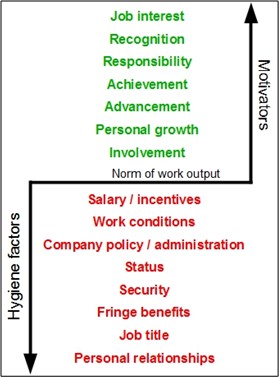The research is over 50 years old – but with the challenges of today – employee engagement, talent retention, remote working, well-being, old ways of working being rejected – it is just as valuable for line managers today as when it was first exposed to the public gaze – back in 1968.
That was when Frederick Herzberg first published his motivator-hygiene theory in HBR, the article being entitled “One More Time, How Do You Motivate Employees?”
The Herzberg model
The argument goes that within each of us, operating singly or in groups, there is norm of work output to which we will achieve. Some aspects of the work environment may drag actual performance below that norm, while others will boost it far above.
What are hygiene factors?
The hygiene factors, below the line “norm of work output”, have to be appropriate. If any of them is significantly adrift from what is needed and reasonable, then performance will suffer. If employees are at odds with any aspect of the reality of their context as listed in the chart, then they will perform less well. But, and it is a very big but, the indication is that how ever well the organisation delivers on the hygiene factors, performance is unlikely to rise above the norm, unless something else and different is also as it should be.
We simply can’t “hygiene factor” our way to high performance
Just to illustrate this there is some evidence that changing salaries will produce a short term up-tick to performance, but the improvement does not last. We very soon shift our expectation (and our spending) to the higher level of disposable income, at which point higher pay has stopped being a motivator. The same is true of other perks and bolt-ons. Strangely, it is with these hygiene factors that so many organisations try to motivate, attract and retain their people. But if there is a war for talent, we can do so much better than trying to outgun rival employers by raising the stakes through our hygiene factors.
…how ever well the organisation delivers on the hygiene factors, performance is unlikely to rise above the norm…
If the hygiene factors don’t work…
… enter the motivators. These include meaningful and rewarding work; recognition; personal and team mastery; being involved and trusted. Once these things are all in place, then performance will begin to fly. This is even true if some of the hygiene factors are not totally ‘good’. It is acknowledged that in those circumstances it is more difficult to motivate people to deliver starring performance, but it can be done. We have seen plenty of teams deliver outstanding performance out of crumbling offices, and using IT that is well past it’s sell-by date. Such de-motivators are no match for high-trust teams, engaged in meaningful work, in a climate that encourages people to experiment and give the best of themselves.
What needs to change and what will it cost?
All of the above is conventional and largely as Herzberg had it, But what follows are additional and valuable insights from the model that don’t often get talked about.
First, we can think of an ‘organisation’ as an entity in its own right. It has a structure, resources, processes and behavioural norms. Then there is the individual manager. This is the person who has a formal, structural relationship with the employees assigned to the manager, flowing from the organisation structure itself. Complicated maybe, but able to be depicted with words, numbers and diagrams. We could call that the “Map”.
But there is also a whole set of interactions between the manager and employees, singly or in groups, and these exist regardless of the formal structure. They are also highly variable and volatile, and operate on the basis of feed forward and feedback loops, each modifying behaviour in the next turn around, with results that are highly emergent in their nature. Messy, unpredictable and intangible, the reality of the organisation is truly complex. This we could call the “Territory”.
A quick glance at the Herzberg chart raises a simple question – who provides what? The answer is that it is the formal organisation that provides the hygiene factors and the individual manager who looks after the motivators. Hence the reason why even with deficient hygiene factors it is still possible for an effective manager to motivate employees to delivery great performance.
A second question is how much does it cost to meet these various needs? The answer is that the hygiene factors cost mega bucks, whereas the motivators are totally free. All they need is the investment of physical, intellectual and emotional energy by the individual manager into getting the motivators to be in a good place, and the superstars in all of us will do the rest.
If you believe that navigating your way around with only a map as your guide is OK, then good luck to you. Our experience suggests that knowledge and understanding of the territory is also rather important!
…high performance is an outcome of good management practices by individual managers – and it’s totally free!
Mirror, mirror on the wall…
So, the bottom line is this. If you want to know why you are not looking at a team of highly motivated superstars, all pulling together, sharing information, solving shared problems and the learning that follows, don’t blame the organisation. The organisation cannot deliver that. Take a walk into the nearest bathroom – they all have one feature in common – and have a look in the mirror. There you will find the cause of all your problems, along with the solution.
The fact of the matter is that high performance is an outcome of good management practices by individual managers – and it’s totally free! Moreover, the effect is long-lasting since it is a change that feeds on itself.
No excuses – no budget required!
So no budget needed and a positive outcome for the business, its people, its customers and suppliers, and its local partners. So why has the Herzberg approach not been adopted more widely? And, especially now with the current focus on employee engagement, linked to ever better performance?
In the first instance, many people have not stumbled across the Herzberg stuff. In the second is that nasty personal accountability stuff implied by the ‘bathroom mirror’ test. Unless the managers in question acknowledge that they are part of the problem there is no way forward. If there are performance problems, and the managers actions are making a difference, then they must be part of the problem. If their actions are not making a difference, then they are part of the problem, by definition.
Then there is that physical, intellectual and emotional energy required to be invested in the organisation’s people, including the building of all-round trust. And which can only come from individual managers.
So, how to get started?
The answer lies in the Herzberg model itself. Check the entries for ‘Responsibility’, ‘Involvement’ and Personal Growth’. Use these as the point of entry into the local system. Go ask the people what needs to change to give them greater feedback ‘above the line’. Including changes in management practices. Run with whatever they come up with to get a process of never-ending experimentation and learning started. Once through the pain barrier of getting started, it’s all great fun, for everyone. What ever you do, make sure you are working “in the territory” not “on the map”
Sounds like better employee experience and better performance – at the same time – and it’s all for free!
Denis Bourne is a Co-founder of VitalOrg and has been helping courageous and curious folk bring greater autonomy to their organisations for over 40 years

